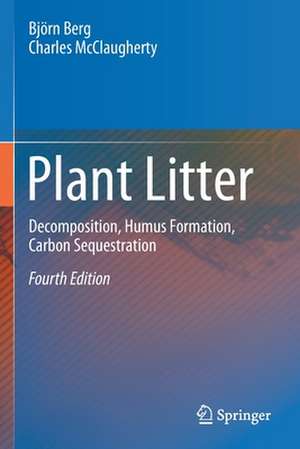Plant Litter: Decomposition, Humus Formation, Carbon Sequestration
Autor Björn Berg, Charles McClaughertyen Limba Engleză Paperback – 4 dec 2021
New knowledge in the fields of phytochemistry and microbial ecology has given a new baseline for discussing the concepts ‘litter decomposition’ and ‘carbon sequestration’. We can also see a rich literature on litter decomposition studies using roots and wood as substrates. These have given new insights in factors that regulate the decomposition rate and as regards roots their contribution to sequestered carbon in humus. Additional facts on the role of temperature vs the litters’ chemical compositionmay in part change our view on effects of climate change.
Further information on applications of the new analytical technique (13C-NMR) for determining organic-chemical compounds has allowed us to develop these parts.
Focus is laid on needle litter of Scots pine as a model substrate as this species has been considerably more studied than other litter species. Also the boreal/northern temperate coniferous forest has in part been given this role. Still, new information may allow us to develop information about litter from further tree species.
| Toate formatele și edițiile | Preț | Express |
|---|---|---|
| Paperback (2) | 946.41 lei 43-57 zile | |
| Springer Berlin, Heidelberg – 27 aug 2016 | 946.41 lei 43-57 zile | |
| Springer International Publishing – 4 dec 2021 | 1001.50 lei 43-57 zile | |
| Hardback (1) | 1007.65 lei 43-57 zile | |
| Springer International Publishing – 4 dec 2020 | 1007.65 lei 43-57 zile |
Preț: 1001.50 lei
Preț vechi: 1221.34 lei
-18% Nou
Puncte Express: 1502
Preț estimativ în valută:
191.64€ • 200.59$ • 159.50£
191.64€ • 200.59$ • 159.50£
Carte tipărită la comandă
Livrare economică 31 martie-14 aprilie
Preluare comenzi: 021 569.72.76
Specificații
ISBN-13: 9783030596330
ISBN-10: 3030596338
Ilustrații: XVI, 332 p. 99 illus., 6 illus. in color.
Dimensiuni: 155 x 235 mm
Greutate: 0.49 kg
Ediția:4th ed. 2020
Editura: Springer International Publishing
Colecția Springer
Locul publicării:Cham, Switzerland
ISBN-10: 3030596338
Ilustrații: XVI, 332 p. 99 illus., 6 illus. in color.
Dimensiuni: 155 x 235 mm
Greutate: 0.49 kg
Ediția:4th ed. 2020
Editura: Springer International Publishing
Colecția Springer
Locul publicării:Cham, Switzerland
Cuprins
Chapter 1 - Introduction.- Chapter 2 - Decomposition as a process: Some main features.- Chapter 3 - Decomposer organisms.- Chapter 4 - Initial litter chemical composition.- Chapter 5 - Changes in substrate composition during decomposition.- Chapter 6 - Chemical constituents as rate regulating: Initial variation and changes during decomposition.- Chapter 7 - Climatic environment.- Chapter 8 - Decomposition of fine root and woody root litter.- Chapter 9 - Decomposition of woody litter and cones.- Chapter 10 - Models that describe litter decomposition and influences on decomposition patterns.- Chapter 11 - Influences on stable litter fractions and carbon sequestration in organic layers.- Chapter 12 - Carbon sequestration rates on a regional scale.
Textul de pe ultima copertă
This book gives basic facts about litter decomposition studies, which are of guidance for scientists who start studies. Since the publication of the third edition, there has been quite a development not only in the field of litter decomposition but also in supporting branches of science, which are important for fruitful work on and understanding of decomposition of plant litter and sequestration of carbon. A consequence is that ‘old established truths’ are becoming outdated.
New knowledge in the fields of phytochemistry and microbial ecology has given a new baseline for discussing the concepts ‘litter decomposition’ and ‘carbon sequestration’. We can also see a rich literature on litter decomposition studies using roots and wood as substrates. These have given new insights in factors that regulate the decomposition rate and as regards roots their contribution to sequestered carbon in humus. Additional facts on the role of temperature vs the litters’ chemical composition may in part change our view on effects of climate change.
Further information on applications of the new analytical technique (13C-NMR) for determining organic-chemical compounds has allowed us to develop these parts.
Focus is laid on needle litter of Scots pine as a model substrate as this species has been considerably more studied than other litter species. Also the boreal/northern temperate coniferous forest has in part been given this role. Still, new information may allow us to develop information about litter from further tree species.
New knowledge in the fields of phytochemistry and microbial ecology has given a new baseline for discussing the concepts ‘litter decomposition’ and ‘carbon sequestration’. We can also see a rich literature on litter decomposition studies using roots and wood as substrates. These have given new insights in factors that regulate the decomposition rate and as regards roots their contribution to sequestered carbon in humus. Additional facts on the role of temperature vs the litters’ chemical composition may in part change our view on effects of climate change.
Further information on applications of the new analytical technique (13C-NMR) for determining organic-chemical compounds has allowed us to develop these parts.
Focus is laid on needle litter of Scots pine as a model substrate as this species has been considerably more studied than other litter species. Also the boreal/northern temperate coniferous forest has in part been given this role. Still, new information may allow us to develop information about litter from further tree species.
Caracteristici
Is the fourth edition, fully revised and updated with much new material Presents the latest research in the fields of phytochemistry and microbial ecology with regard to litter decomposition and carbon sequestration Provides information on the role of "climate" versus the litter's chemical composition Focuses on needle litter of Scots pine as model substrate Exhibits state-of-the-art information on the new analytical technique 13C-NMR
Recenzii
“A major component of ecosystems and plays a major role in determining their structure and function by virtue of being the source of energy for a large diversity of heterotrophic organisms. … provides a comprehensive account of the subject based on the extensive studies in boreal forest ecosystems. … The fundamentals are applicable to a great extent also to the process in other climatic regions where the researchers would surely find the book useful in many ways.” (Brij Gopal, International Journal of Ecology and Environmental Sciences, Vol. 41 (3-4), 2015)
“The book … presents a clear, thorough introduction to plant litter decomposition processes, providing detailed coverage of specific topics and ending with a summary chapter on regional carbon sequestration rates. It contains numerous diagrams, tables, and figures, a valuable glossary, 24 pages of references, and appendixes specific to field experiments and analytical methods that will be useful to researchers for many years to come. Summing Up: Highly recommended. Upper-division undergraduates and above.” (D. L. Richter, Choice, Vol. 51 (11), July, 2014)
"The authors of the volume ‘Plant Litter’ present an up-to-date and interesting contribution … . The book is well arranged, relatively easy to read, contains fantastic graphics … . this fundamental and rather detailed book is an absolutely necessary resource about transformation and decomposition of plant litter ... . In summary, we strongly recommend this book for all scientists concerned with … plant litter … . The authors can be congratulated for their impressive efforts in publishing this highly professional volume." (Oliver Bens, Reinhard F. Hüttl, Journal of Plant Physiology, Vol. 161, 2004)
"The work of Berg and Mc Claugherty resumes the state of the art concerning litter decomposition mainly in boreal forests but also in a few temperate situations. … this book is a remarkable synthesis of the current knowledge about the decomposition of plant residues in forest ecosystems. … This book is well structured and gives a comprehensive overview about the process of litter decompositions and itis a well written synthesis of the enormous work done by B.Berg during the last two decades." (Bernd Zeller, Annals of Forest Science, Issue 2, 2004)
“The book … presents a clear, thorough introduction to plant litter decomposition processes, providing detailed coverage of specific topics and ending with a summary chapter on regional carbon sequestration rates. It contains numerous diagrams, tables, and figures, a valuable glossary, 24 pages of references, and appendixes specific to field experiments and analytical methods that will be useful to researchers for many years to come. Summing Up: Highly recommended. Upper-division undergraduates and above.” (D. L. Richter, Choice, Vol. 51 (11), July, 2014)
"The authors of the volume ‘Plant Litter’ present an up-to-date and interesting contribution … . The book is well arranged, relatively easy to read, contains fantastic graphics … . this fundamental and rather detailed book is an absolutely necessary resource about transformation and decomposition of plant litter ... . In summary, we strongly recommend this book for all scientists concerned with … plant litter … . The authors can be congratulated for their impressive efforts in publishing this highly professional volume." (Oliver Bens, Reinhard F. Hüttl, Journal of Plant Physiology, Vol. 161, 2004)
"The work of Berg and Mc Claugherty resumes the state of the art concerning litter decomposition mainly in boreal forests but also in a few temperate situations. … this book is a remarkable synthesis of the current knowledge about the decomposition of plant residues in forest ecosystems. … This book is well structured and gives a comprehensive overview about the process of litter decompositions and itis a well written synthesis of the enormous work done by B.Berg during the last two decades." (Bernd Zeller, Annals of Forest Science, Issue 2, 2004)











